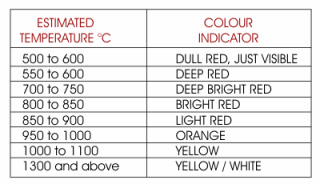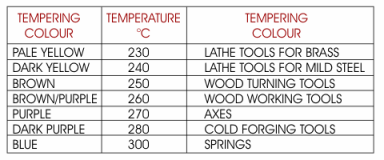woodbloke
Established Member
Aled - however you do it, tempering requires a second quench after hardening. There's an account here of three different highly technical ways of tempering, all of which require a quench of some sort. Again here in this description of the process:Aled Dafis":1w44cdj7 said:That's also how I do it. The ideal temp. for tempering is 200 - 210 degrees C, but I find that my oven does the job best when set to 230 degrees - basically you're looking for a hint of light brown colouring. I just leave them in the oven for around 15 - 20 minutes and then turn the oven off and let them cool naturally. The length of time an iron is tempered for is not critical so long as the metal is heated all the way through.
Cheers
Aled
"Color tempering is based on the oxide colors that appear on the surface of steel, as it is heated. When you slowly heat a piece of polished hardened steel, you can see the surface turn various colors as the temperature changes. These colors indicate structural changes are taking place within the metal. Once the proper color appears, the part is rapidly quenched to prevent further structural change. In color tempering, the surface of the steel must be smooth and free of oil. The part may be heated by a torch, in a furnace, over a hot plate, or by radiation. "
Whichever way you do it, if it's not quenched, the metal ain't being tempered - Rob






